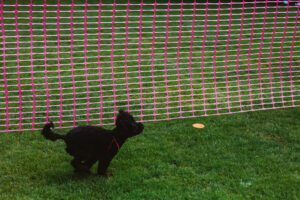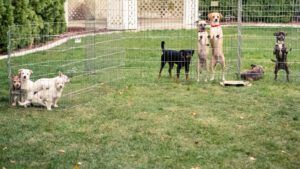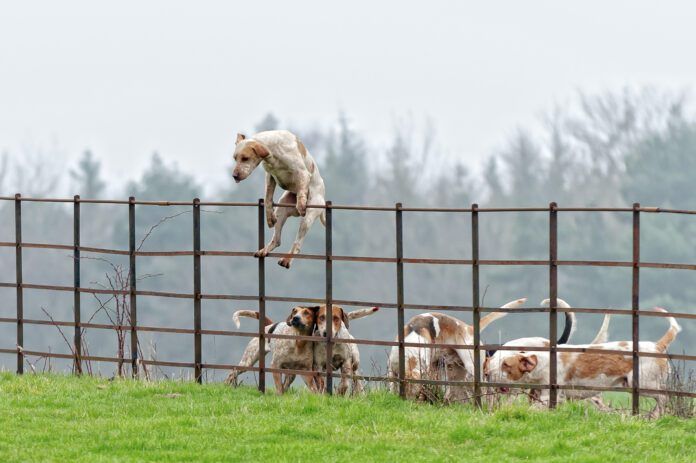Whether you’re traveling, remodeling your backyard, or need a fence to put up at camp or at your RV, a good outdoor temporary dog fencing for dogs can keep you and your dog happy. A portable temporary fence can give your dog a little freedom, but it must be safe and secure.
But not just any old fence will do, and the internet is flooded with temporary dog fence ideas—many of which won’t give us peace of mind.
Types of quality temporary dog fences include:
- Plastic mesh
- Wire mesh
- Ex-pens, also called exercise pens
- Free-standing kennels with or without a roof
- Metal no-dig fence panels by the piece
Let’s dig into more about each of these choices.
Plastic Mesh as a Temporary Dog Fence

Often called snow fence or safety fence, this is typically the type of fencing that you might see at construction sites. It comes in many colors. Standard size is 4 feet high by 100 feet long but can also be purchased in shorter heights and smaller rolls.
You can use metal rods to secure it or wrap it around trees if the area supports such an option. This is what I used to patch a tree made hole in my fence until the fencing repair people could get me on their schedule. I have also used this for a temporary fence for a rescue group picnic for the dogs who came along to socialize. It is often used at dog sporting events, where the dogs are under verbal control or on a leash. This is not the best fence to choose if your dog will be unsupervised.
You can buy this type of fence online from home supply stores as well as U-Line and Amazon. There are countless brands, some of which are marketed as temporary dog fences, and some are simply sold as safety/snow fencing.
Pros of plastic mesh fencing: Relatively inexpensive, easy to use, very visible.
Cons of plastic mesh fencing: Can be difficult to secure, making it of questionable use for a determined canine escape artist, even with a secure bottom.
Wire Mesh as a Temporary Dog Fence
There are a multitude of wire mesh options, including chicken wire, which is made of flexible galvanized steel to varying strengths of welded steel mesh. The thickness determines the cost, with chicken wire being less expensive than a sturdier welded weave. This can make a very solid temporary fence along with the metal poles necessary to secure it.
Pros of wire fence: Sturdier than plastic mesh, which makes it easier to handle while installing install and a stronger choice than plastic, especially for a large dog. Woven wire chicken wire can be relatively inexpensive.
Cons of wire fence: Welded steel can be nearly as expensive and challenging to install as a permanent fence when looking at the hardier weaves. Yardgard offers quality fence in this category.
Exercise Pens as a Temporary Fence for Dogs

Credit: Debibishop | Getty Images
You can get several ex-pens and link them together as well as securing them to the ground with the metal rods for such that come with most models. There are also some very nice choices meant to be used outdoor models that come in various sizes, including quite large. They come in varying heights, with or without built-in gates.
I prefer them without gates. I simply open the securing connectors when releasing the dog(s). I find that to be the more secure option. Gates can be accidentally opened. The clips, when clipped properly, are far less likely to do so.
Pros of ex-pens: In many ways, this can be the most inexpensive option, especially if you find some at garage sales, and they’re oh-so-easy to set up.
Cons of ex-pens: These aren’t the most sturdy option for determined escapers. Brands that I found for outdoor use include FXW Rollick and Zippity Outdoor Products. Most are widely available with FXW even being available on Chewy. They also make indoor versions that can be used outdoors. Midwest products offers a wide variety of ex-pen options as well.
Free-Standing Kennels as Temporary Fencing for Dogs
This type of temporary fencing is exactly what it sounds like. An actual kennel, freestanding and not needing to be secured in ground, available with or without a roof. They are probably the most secure type of temporary fencing of the options, simply because the fencing for these is so high, even more secure when you opt for the type with a roof.
Pros of free-standing kennels: Kennels are generally secure, easy to set up, and self-shaded when opting for roofed version.
Cons of free-standing kennels: Kennels are expensive for a large enough option to include sufficient room to run, perhaps the least attractive option if you are not fond of the cage-like look. Brands that I liked include Veikhous, Retriever Lodge, KennelMaster, and K9 Kennelstore.
Metal No-Dig Fence Panels as Temporary Fencing for Dogs
I found this to be a most interesting option for a temporary dog fence. Some of the options don’t really specify the type of metal used but other options mention wrought iron. All state there is no need to dig to install and that only a rubber mallet is necessary to pound each piece into place. They range in heights from 24 inches to 48 inches. You choose how many panels to purchase and that determines the total cost.
Pros of metal no-dig fence panels: They’re easy to install and relatively inexpensive compared to some other options, sturdy if you choose wrought iron.
Cons of metal no-dig fence panels: The lack of posts concerns me, as it can make this option much less secure. Brands for this option include Zippity Outdoor Products and Jinligogo (wrought iron option).
Considerations In Choosing a Temporary Dog Fences
Some important points to take into consideration that can help you choose the best option for your dog, the location of the fence, and how long you’ll need to use it.
Height of the fence: For smaller dogs, 4 feet is sufficient. Large dogs may need 6 feet. Keep in mind that most experts suggest that a dog can jump one to three times his shoulder height. Additionally, many dogs can and will scale a metal fence easily, especially younger dogs.
Sturdiness of the fence: Your dog should not be able to wobble the fence or tip it over by jumping on it or leaning against it.
Your dog’s climbing/digging abilities: If your dog is an expert climber or digger, then this means special additions for your temporary fence are necessary. For your darling digger, I love Dig Defence. For the climbers, you can consider a Coyote Roller. If you’re clever, y ou may be able to do a DIY version using inexpensive PVC as opposed to the original metal version. Originally created to keep coyotes out of fenced-in areas, it also keeps your climbing canine monkey inside.
Your dog’s energy and activity levels: If you have an adolescent who considers zoomies light cardio, then you need more room than if you have a senior who just wants to sit/lay outside and meditate with nature. Of course, this also depends on how you intend to use the fence.
Your dog’s reactivity level: If your dog is the type to bark or react in any way to typical triggers that may include other dogs, passing humans, children playing, bicycles/wheeled recreational toys, cars, etc., then what they see from inside of the fence is an important consideration for the type or fencing as well as the location of such. Again, this will depend on how you intend to use this temporary fence.
Typical Uses for a Temporary Dog Fence
All the above-mentioned options can be successfully used on a temporary basis while remodeling or saving up for a permanent fence. Some will require more supervision than others, such as the snow fence, no-dig panels, and ex-pen options.
If you are installing this temporary fence on grass or dirt, which is the typical choice, then metal with secured poles will be the sturdiest choice but also the most labor intensive to install. This is the way to go if you have a large sturdy dog who will challenge the fence. Add the Dig Defence options for diggers or the Coyote Roller top for climbers.
But if you truly want this fence to be temporary and as low maintenance as possible, the best prevention for digging is simply supervision. One cannot say the same for jumpers, who will jump whether supervised or not. So, choose as tall a fence as appropriate for your beloved jumper. For your reactive dog, you can easily cover the metal fence with privacy screen made from polyethylene mesh.
The kennel options can be placed on either a grass surface or a concrete surface such as a driveway, if you are remodeling your yard. This option requires the least supervision, if you properly secure it, but it’s also typically the most confining option, which is not ideal depending on your needs.
For traveling, the choices are less abundant. How you are traveling determines the size of your temporary fence. The larger options can be stored on an RV/motor home. Smaller options can be transported on a roof rack. Most of the travel options are basically larger metal ex-pen type containment systems that are suited for outdoors rather than indoors. Or you can link several smaller ex-pens together to create a larger area, along with the metal yard poles that typically come with the pens. There are also very lightweight interlinking plastic ex-pen options for smaller or more sedate dogs. Several of the No Dig Panels are marketed as RV fences for traveling. Supervision is recommended for these types of temporary fences, especially since traveling can add some excitement or anxiety to your dog’s typical temperament.
Whatever option you end up with, think in terms of safety and cover all your bases—climbing, jumping, digging—and you should be able to keep your dog safe, temporarily, of course.







We have some of the metal no dig fencing around our front walk and front door. I love it. For us it is more permanent and less temporary. I would never trust my dogs in it without supervision. It does however prevent loose dogs in the neighborhood from running up to my toy dogs and it provides a second barrier at our front door when we have a new dog that we are fostering. It is great for a late-night quick potty run since the area is lights up with our front porch lights and the entire pack can go out without anyone being able to disappear. It is also more attractive and sturdier than most of the temporary options. We even have a gate across the walkway for easy human access.
I installed a four foot high post and rail fence around our five acres. The day it was completed, our 20 year old Bearded Collie saw a deer and hopped over it with no
Problem. I could have saved the money but having a large corral placated me anyway.
Ten year old. Typo